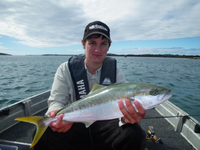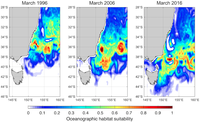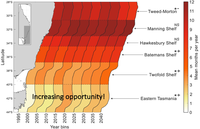Increasing opportunity for kingfish in Tasmanian waters
Curtis Champion, 03 Aug 2018.
Sightings of yellowtail kingfish in Tasmanian waters have been regularly logged with Redmap since the program began. These records are particularly valuable because they indicate that kingfish from eastern Australia could be on the move south, suggesting that some dedicated scientific research may be necessary to get to the bottom of what’s going on.
In this article, PhD student and kingfish project leader Curtis Champion describes recently published findings that show the ocean conditions favoured by kingfish are moving further south, and importantly, indicate that an increase in the number of months each year that these conditions persist off Tasmania is very likely in the future.
-
Sighting: Daniel Paull with a Tasmanian kingfish capture that he logged with Redmap! (Redmap sighting: http://www.redmap.org.au/sightings/670/)
-
Suitable ocean conditions for yellowtail kingfish (Seriola lalandi) are shifting south and are persisting off Tasmania for longer each year.
-
The number of months per year that are suitable of kingfish at the southern edge of the current range is predicted to increase in the near-future, meaning more opportunity for this species in eastern Tasmania.
It’s thought that yellowtail kingfish were historically found in the waters of mainland Australia and that ocean temperatures off Tasmania were a bit too cold to host this fish. However, occasional sightings of kingfish over the past 15 years by Tasmanian recreational anglers and divers, many of which have been logged with Redmap, potentially indicate that kingfish might be moving further south as a result of ocean warming in this region. These sightings were all the motivation that researchers from the Institute for Marine and Antarctic Studies and CSIRO Oceans and Atmosphere needed to look a little deeper into links between changing ocean conditions and the distribution of kingfish from south-eastern Australia. The project began in 2016, and now some of the results have been finalised and published!
Firstly, we set about identifying the combination of ocean conditions, like temperature and current speeds, that kingfish strongly associate with. We then used ocean data, such a sea surface temperature collected over the past 20 years by satellites to assess if the ocean conditions that kingfish prefer have indeed moved south between 1996 to 2017.
And yes! The conditions that kingfish prefer have indeed shifted south since 1996 and have done so at a rapid rate! We found that the location of ocean conditions that are absolutely optimal for kingfish have been moving south by about 95 km per decade since 1996, and the southern edge of ocean conditions that kingfish can tolerate, but aren’t quite optimal, have moved south even faster (about 110 km per decade) and now occur off Tasmania for a few months each year.
Secondly, we looked into the number of months each year that suitable conditions for kingfish occur in Tasmanian waters, and how this ‘window of opportunity’ for kingfish is likely to change in the future. By focusing on the duration that kingfish can persist for in Tassie, we were able to assess if opportunity for kingfish to inhabit Tasmanian waters, and opportunity for Tasmanian anglers to target kingfish, is likely to increase in the future. We found that in 1996, Tasmanian ocean conditions were suitable for kingfish for approximately 1 month of the year, but by 2016 approximately 2.5 months of the year were suitable. This means that the window of opportunity for kingfish in Tasmania increased by around 1.5 months over 20 years. This study also used ocean forecasts to assess the likely future for kingfish in Tasmania, which indicated that by 2040 the Tasmanian coastal ocean will be suitable for kingfish for approximately 4 months of the year.
Key points
1. The ocean conditions that are preferred by kingfish from eastern Australia have moved south at a rate of about 100 km per decade between 1996 – 2017.
2. The number of months each year that the ocean conditions preferred by kingfish occur in Tasmanian waters has already increased since 1996, and is predicted to continue to increase in the near-future.
3. How long suitable ocean conditions for kingfish persist for each year in defined regions (like eastern Tasmania) can be considered a measure of opportunity for kingfish populations to increase and persist, and also a measure of fishing opportunity. We’ve found that opportunity is increasing off Tasmania with ocean warming, but opportunity is likely to be decreasing at the northern edge of this species distribution (i.e. southern QLD/northern NSW).
Want to know more?
The study analysing how quickly suitable ocean conditions for kingfish from eastern Australia have moved south between 1996 – 2017 is published in the journal Global Change Biology, and can be viewed here: https://onlinelibrary.wiley.com/doi/10.1111/gcb.14398
The study predicting future changes in the number of months each year that are suitable for kingfish in six eastern Australian marine regions is published in the journal Marine and Freshwater Research, and can be viewed here: http://www.publish.csiro.au/mf/MF17387
If you have any other enquires about this work, don’t hesitate to contact Curtis at Curtis.Champion@utas.edu.au














